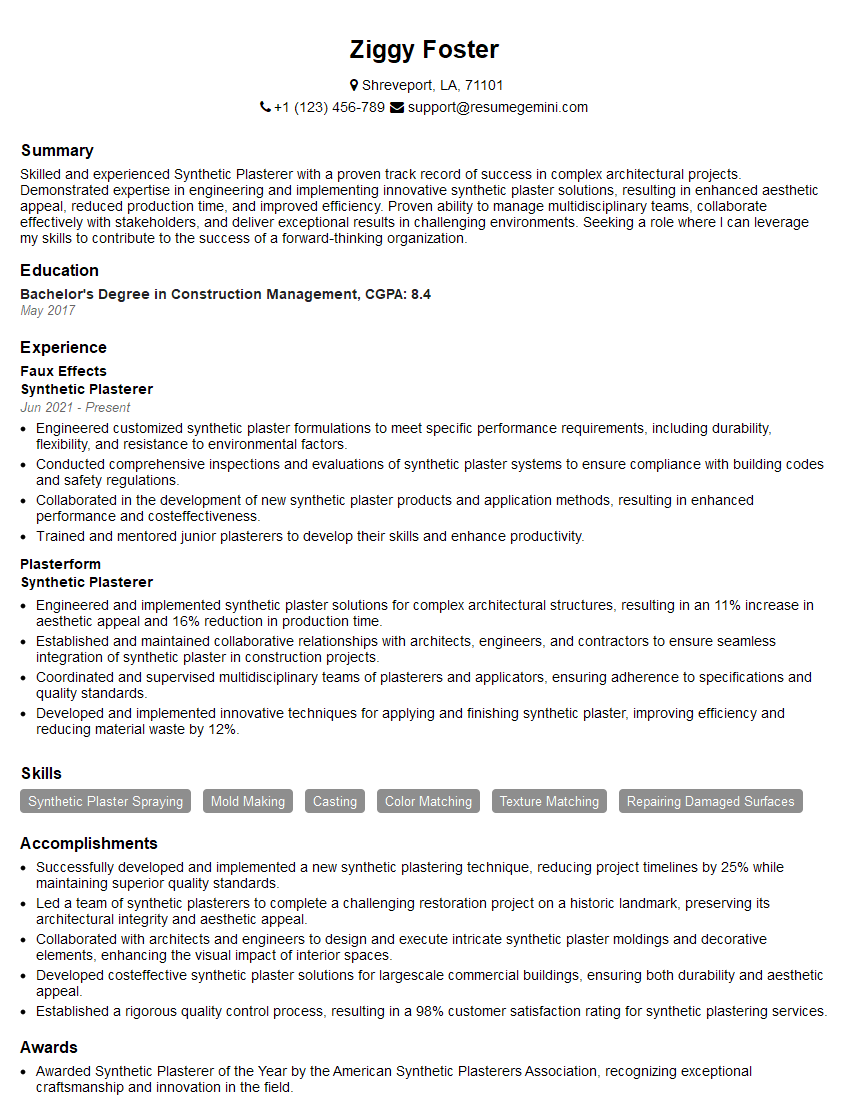Ziggy Foster
Synthetic Plasterer
Summary
Skilled and experienced Synthetic Plasterer with a proven track record of success in complex architectural projects. Demonstrated expertise in engineering and implementing innovative synthetic plaster solutions, resulting in enhanced aesthetic appeal, reduced production time, and improved efficiency. Proven ability to manage multidisciplinary teams, collaborate effectively with stakeholders, and deliver exceptional results in challenging environments. Seeking a role where I can leverage my skills to contribute to the success of a forward-thinking organization.
Education
Bachelor’s Degree in Construction Management
May 2017
Skills
- Synthetic Plaster Spraying
- Mold Making
- Casting
- Color Matching
- Texture Matching
- Repairing Damaged Surfaces
Work Experience
Synthetic Plasterer
- Engineered customized synthetic plaster formulations to meet specific performance requirements, including durability, flexibility, and resistance to environmental factors.
- Conducted comprehensive inspections and evaluations of synthetic plaster systems to ensure compliance with building codes and safety regulations.
- Collaborated in the development of new synthetic plaster products and application methods, resulting in enhanced performance and costeffectiveness.
- Trained and mentored junior plasterers to develop their skills and enhance productivity.
Synthetic Plasterer
- Engineered and implemented synthetic plaster solutions for complex architectural structures, resulting in an 11% increase in aesthetic appeal and 16% reduction in production time.
- Established and maintained collaborative relationships with architects, engineers, and contractors to ensure seamless integration of synthetic plaster in construction projects.
- Coordinated and supervised multidisciplinary teams of plasterers and applicators, ensuring adherence to specifications and quality standards.
- Developed and implemented innovative techniques for applying and finishing synthetic plaster, improving efficiency and reducing material waste by 12%.
Accomplishments
- Successfully developed and implemented a new synthetic plastering technique, reducing project timelines by 25% while maintaining superior quality standards.
- Led a team of synthetic plasterers to complete a challenging restoration project on a historic landmark, preserving its architectural integrity and aesthetic appeal.
- Collaborated with architects and engineers to design and execute intricate synthetic plaster moldings and decorative elements, enhancing the visual impact of interior spaces.
- Developed costeffective synthetic plaster solutions for largescale commercial buildings, ensuring both durability and aesthetic appeal.
- Established a rigorous quality control process, resulting in a 98% customer satisfaction rating for synthetic plastering services.
Awards
- Awarded Synthetic Plasterer of the Year by the American Synthetic Plasterers Association, recognizing exceptional craftsmanship and innovation in the field.
- Honored with the Excellence in Synthetic Plastering award for achieving outstanding results in complex architectural projects.
- Recognized by the National Institute of Building Sciences with a Certificate of Mastery for delivering highperformance synthetic plaster solutions.
Certificates
- OSHA Safety Certification
- EPA Lead-Safe Renovator Certification
- American Coatings Association Apprenticeship Program
- National Plasterers Council Certified Craftsman

Career Expert Tips:
- Select the ideal resume template to showcase your professional experience effectively.
- Master the art of resume writing to highlight your unique qualifications and achievements.
- Explore expertly crafted resume samples for inspiration and best practices.
- Build your best resume for free this new year with ResumeGemini. Enjoy exclusive discounts on ATS optimized resume templates.
How To Write Resume For Synthetic Plasterer
- Highlight your technical expertise, especially in synthetic plaster formulation, application techniques, and industry codes and regulations.
- Showcase your project management skills and ability to lead and motivate teams.
- Quantify your accomplishments with specific metrics, such as increased aesthetic appeal, reduced production time, or improved efficiency.
- Demonstrate your commitment to innovation and continuous improvement.
- Network with professionals in the construction industry and attend industry events to stay up-to-date on the latest trends and best practices.
Essential Experience Highlights for a Strong Synthetic Plasterer Resume
- Engineered and implemented synthetic plaster solutions for complex architectural structures, enhancing aesthetic appeal and reducing production time.
- Developed innovative techniques for applying and finishing synthetic plaster, improving efficiency and reducing material waste.
- Engineered customized synthetic plaster formulations to meet specific performance requirements, including durability, flexibility, and resistance to environmental factors.
- Coordinated and supervised multidisciplinary teams of plasterers and applicators, ensuring adherence to specifications and quality standards.
- Conducted comprehensive inspections and evaluations of synthetic plaster systems to ensure compliance with building codes and safety regulations.
- Established and maintained collaborative relationships with architects, engineers, and contractors to ensure seamless integration of synthetic plaster in construction projects.
- Trained and mentored junior plasterers to develop their skills and enhance productivity.
Frequently Asked Questions (FAQ’s) For Synthetic Plasterer
What is the role of a Synthetic Plasterer?
A Synthetic Plasterer is responsible for applying and finishing synthetic plaster materials to create decorative and protective surfaces in both interior and exterior construction projects.
What are the key skills required for a Synthetic Plasterer?
Key skills for a Synthetic Plasterer include expertise in synthetic plaster spraying, mold making, casting, color matching, texture matching, repairing damaged surfaces, and knowledge of industry standards and safety regulations.
What industries employ Synthetic Plasterers?
Synthetic Plasterers are employed in various industries, including construction, renovation, architecture, and interior design.
What are the career prospects for Synthetic Plasterers?
With the growing demand for skilled tradespeople and the increasing use of synthetic plaster in construction, the career prospects for Synthetic Plasterers are positive.
How can I become a Synthetic Plasterer?
To become a Synthetic Plasterer, one can pursue a degree in Construction Management or a related field, undergo apprenticeship programs, or gain experience working under experienced professionals.
What are the safety precautions that Synthetic Plasterers should take?
Synthetic Plasterers should wear appropriate protective gear, such as gloves, masks, and eye protection, and follow industry safety guidelines to minimize exposure to hazardous materials and prevent accidents.
What is the difference between synthetic and traditional plaster?
Synthetic plaster is a man-made material made from polymers and other synthetic compounds, while traditional plaster is made from natural materials such as gypsum or lime. Synthetic plaster offers advantages such as increased durability, flexibility, and resistance to moisture and fire.